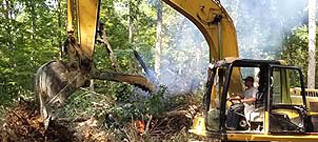State Says Proposed Regulations Represent Significant Step Forward by Requiring State-of-the-Art Environmental Site Design on All New Development and Redevelopment
BALTIMORE (Oct. 21, 2008)—On Friday, Oct. 17, the Maryland Department of Environment (MDE) posted its proposed regulations to implement the Stormwater Management Act of 2007, which requires developers to use state-of-the-art Environmental Site Design practices wherever possible to control runoff and pollution from both new development and redevelopment. This comprehensive approach to reducing stormwater runoff and pollution uses a combination of enhanced site planning techniques, alternative permeable covers, vegetative buffers, and small-scale treatment practices to address the impacts associated with development.
Maryland Department of the Environment Deputy Secretary Bob Summers said: “With a renewed sense of urgency, Maryland has taken significant actions to clean up pollution from wastewater treatment plants, agriculture, car emissions, and power plants—but stormwater runoff remains a challenge. These new regulations carry out the legislature’s mandate in passing the 2007 Stormwater Management Act, and they are what we need in Maryland to ensure that stormwater pollution from new development and redevelopment is controlled as much as possible to significantly advance our Bay restoration efforts in urban and suburban watersheds.”
Polluted stormwater runoff damages local waterways and the Chesapeake Bay because it spreads excess nutrients, sediment, toxic chemicals, and trash and causes stream erosion and flooding. According to the Chesapeake Bay Program, 17 percent of phosphorus, 11 percent of nitrogen, and 9 percent of sediment loads to the Bay come from urban and suburban runoff. Maryland is committed to reducing nutrient and sediment pollution from stormwater runoff in the Bay watershed as part of the 2000 Chesapeake Bay Agreement.
The proposed regulations, along with a tentative permit for Montgomery County’s storm sewer system issued in September that addresses retrofitting existing development by an additional 20 percent and an updated general permit for stormwater from new construction due to be released later this month, demonstrate Maryland’s comprehensive approach to addressing what is nationally recognized as a serious problem.
New requirements of the stormwater regulations include:
-- Environmental Site Design (ESD)/Low Impact Development practices must be used wherever possible on new development sites.
-- ESD design practices will be added to Maryland’s Stormwater Design Manual.
-- Local governments must adopt appropriate ordinances to ensure the new policies and practices in the Maryland Stormwater Design manual are implemented and enforced.
-- A comprehensive stormwater management plan review and approval process must consider all aspects of project planning, design, and construction from initial conception through final approval.
-- New standards for sites under redevelopment include reducing existing impervious area by at least 50 percent, implementing ESD to provide water quality treatment for at least 50 percent of the existing impervious area, or using a combination of both options to address at least 50 percent of the existing site’s impervious area.
Since MDE began work on the stormwater regulations in May 2007, the agency held numerous public meetings and received significant comments from environmental groups, local governments, developers, and the public. Final steps in the regulatory review process include a 30 day formal comment period after the publication of the proposed regulations in the Maryland Register on November 21, 2008, as well as a public hearing on December 8, 2008, at MDE’s headquarters at 1800 Washington Boulevard in Baltimore, with formal regulations anticipated to be adopted in January 2009.
“There are both economic and environmental benefits to changing Maryland’s stormwater management program to improve our water quality, protect our stream channels, and restore our watersheds, said MDE Director of Water Management Jay Sakai. “Cleaning up polluted stormwater runoff also reduces threats to public health and improves our access to clean rivers, streams, and the Coastal and Chesapeake Bays.”
On April 24, 2007, Governor Martin O’Malley signed the “Stormwater Management Act of 2007,” which became effective on October 1, 2007. Prior to this Act, environmental site design (ESD) was encouraged through a series of credits found in Maryland’s Stormwater Design Manual. The Act requires that ESD, through the use of nonstructural best management practices and other better site design techniques, be implemented wherever possible for both new development and redevelopment. Charged with implementation, MDE has made changes to regulations, the 2000 Maryland Stormwater Design Manual, and other guidance materials.
The revised regulations are available online at: http://www.mde.state.md.us/Programs/WaterPrograms/SedimentandStormwater/swm2007.asp
Stormwater management controls nonpoint source pollution through the use of nonstructural and structural best management practices to intercept runoff from developed areas, filtering and treating stormwater runoff, and then discharging it at a controlled rate into the streams, rivers, and the Coastal and Chesapeake Bays.
In addition to improving stormwater controls through regulations on new and existing development, MDE encourages property owners to reduce stormwater runoff by using permeable paving surfaces such as wood decks, bricks, and concrete lattice; directing runoff from impervious surfaces into vegetated areas; allowing vegetation or “buffer strips” to grow alongside waterways; planting trees, shrubs, and groundcover; discontinuing or limiting the use of chemical fertilizers and pesticides; and reducing bare patches on lawns.
More tips and information about stormwater runoff can be found online at:
http://www.mde.state.md.us/Programs/WaterPrograms/SedimentandStormwater/
Source: Maryland Department of the Environment


